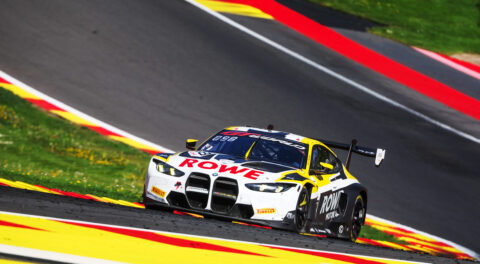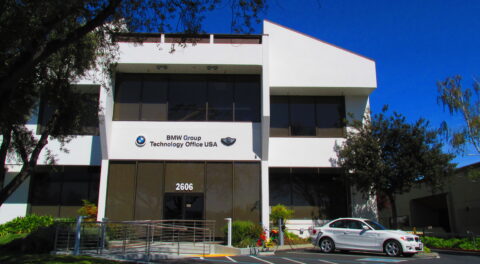Read this only if you like combustion engines. Or you like electric cars. Or hybrid cars. Or if you like race cars—or if you don’t. Or if you like M cars… or non-M cars.
Read this only if you like progress—or awesomeness.

The new BMW M Hybrid V8 looks at the previous three generations of BMW prototypes.
On September 22, BMW M Motorsport held the world premiere of the BMW M Hybrid V8 in its race livery. The Petersen Museum in Los Angeles hosted the event that included the previous three generations of BMW prototype race cars lined up in front of the initially veiled hybrid GTP car. The presence of the 1981 March BMW M1/C, the 1986 March 86G BMW GTP, and the 1999 Le Mans-winning V12 LMR loomed paternally like Doc Hudson watching proudly as Lightning McQueen came into his own.
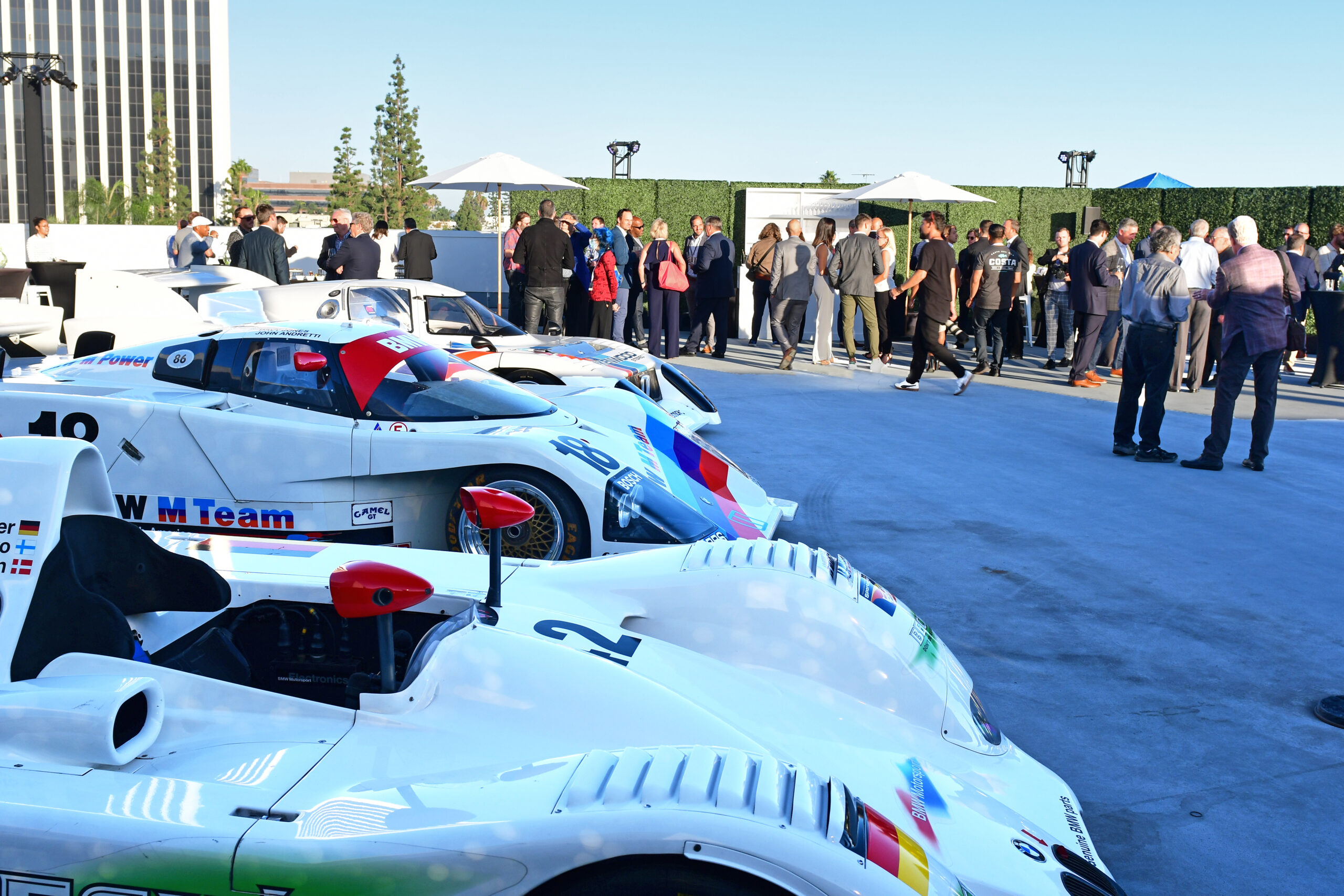
The rooftop of the Petersen Museum was a perfect spot for the premiere, and guaranteed that no one would drive off with the cars.
Revealing the car in Los Angeles was more than just finding cool rooftop space at a museum that hosts its own share of automotive royalty. “The reason we’re here in California is because this is the biggest M market, and it’s also the biggest electrified market, so this is a perfect place to show the car,” said Tom Plucinsky, the head of BMW NA’s Product and Technology Communications department.

Bobby Rahal (shades) chats with BMW M Motorsport’s Andreas Roos (left) and Tom Plucinsky. (Driver Augusto Farfus appears far left.)
This debut—and this car—are more than just the introduction of a new race car. “The car is a symbol of the next generation of BMW M cars,” Plucinsky says. “It really is the first step of electrification of M. Very soon we will be unveiling an SAV from M that is also electrified; the XM will be very similar to this, a V8 with a hybrid component to it. This is the way for us to take [electrified] racing and show it to the masses.”
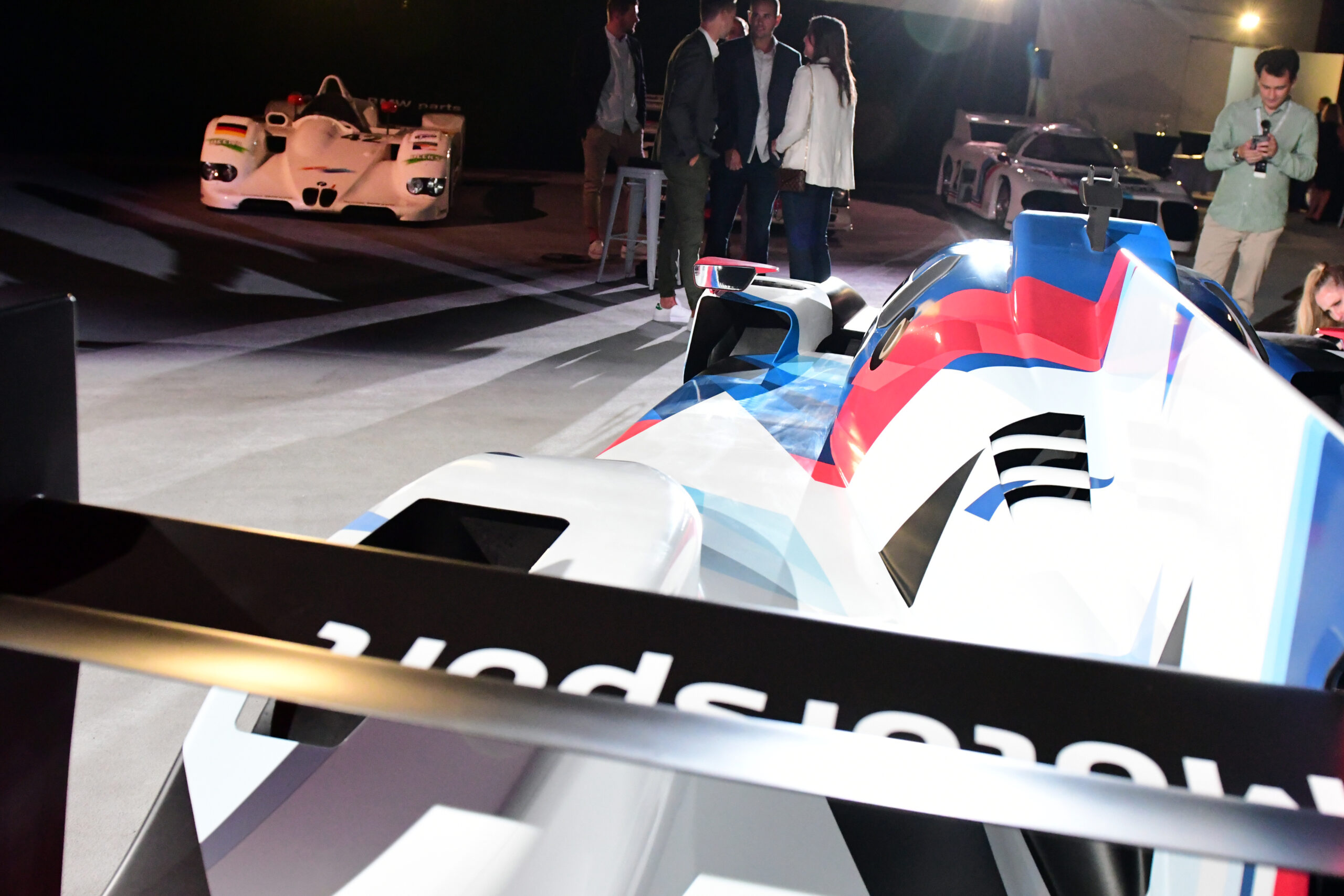
It’s amazing to think it has been 25 years since BMW last developed a prototype race car.
If the reaction of the mini-masses Thursday night is any indication, showing the BMW M Hybrid V8 GTP to the racing masses will be well received. That reception will start after a public display at Petit LeMans in Atlanta later this week, on the track with BMW Team RLL at the 24 Hours of Daytona.
This is the first prototype developed by BMW M Motorsport in 25 years. The last prototype car, the V12 LMR, won the 24 Hours of Le Mans in 1999. With the Hybrid V8’s first race scheduled to be the 2023 24 Hours of Daytona, the excitement is building, especially with the newly announced 2023 BMW M Team RLL IMSA season drivers. Connor DePhillippi, Nick Yelloly, Augusto Farfus, and Colton Herta were on hand for this premiere, and will be joined on Team RLL by Philipp Eng for the 2023 season.
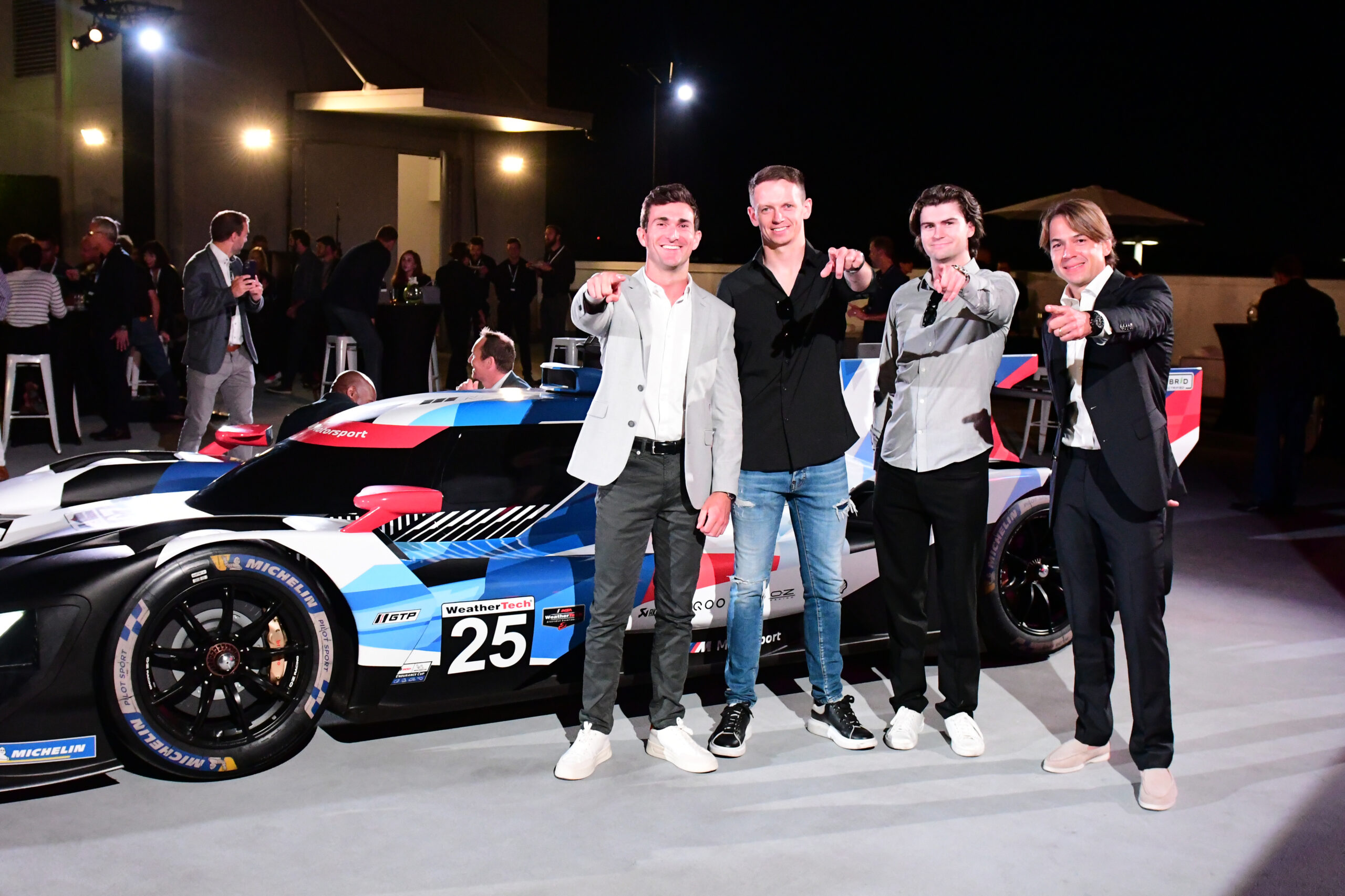
Pointing to the future, BMW M Team RLL drivers for the 2023 IMSA season and endurance racing include Connor DePhillippi, Nick Yelloly, Colton Herta, and Augusto Farfus.
That’s a fantastic team with great experience, but it’s DePhillippi who has a unique perspective on this progression of BMW M Motorsport prototype cars; he has driven both the V12 LMR and the new Hybrid V8 this summer. “The LMR and M Hybrid V8 are two different animals in their own ways,” DePhillippi said. “You have the raw, open-cockpit, wind-to-the-helmet feel of the LMR, where you feel it always dancing on the edge. It gives you the confidence to still muscle it around at low speed, but it can bite you if you’re not careful at high speed. The steering is less direct, and doesn’t quite have that feedback that our new GTP car has.”
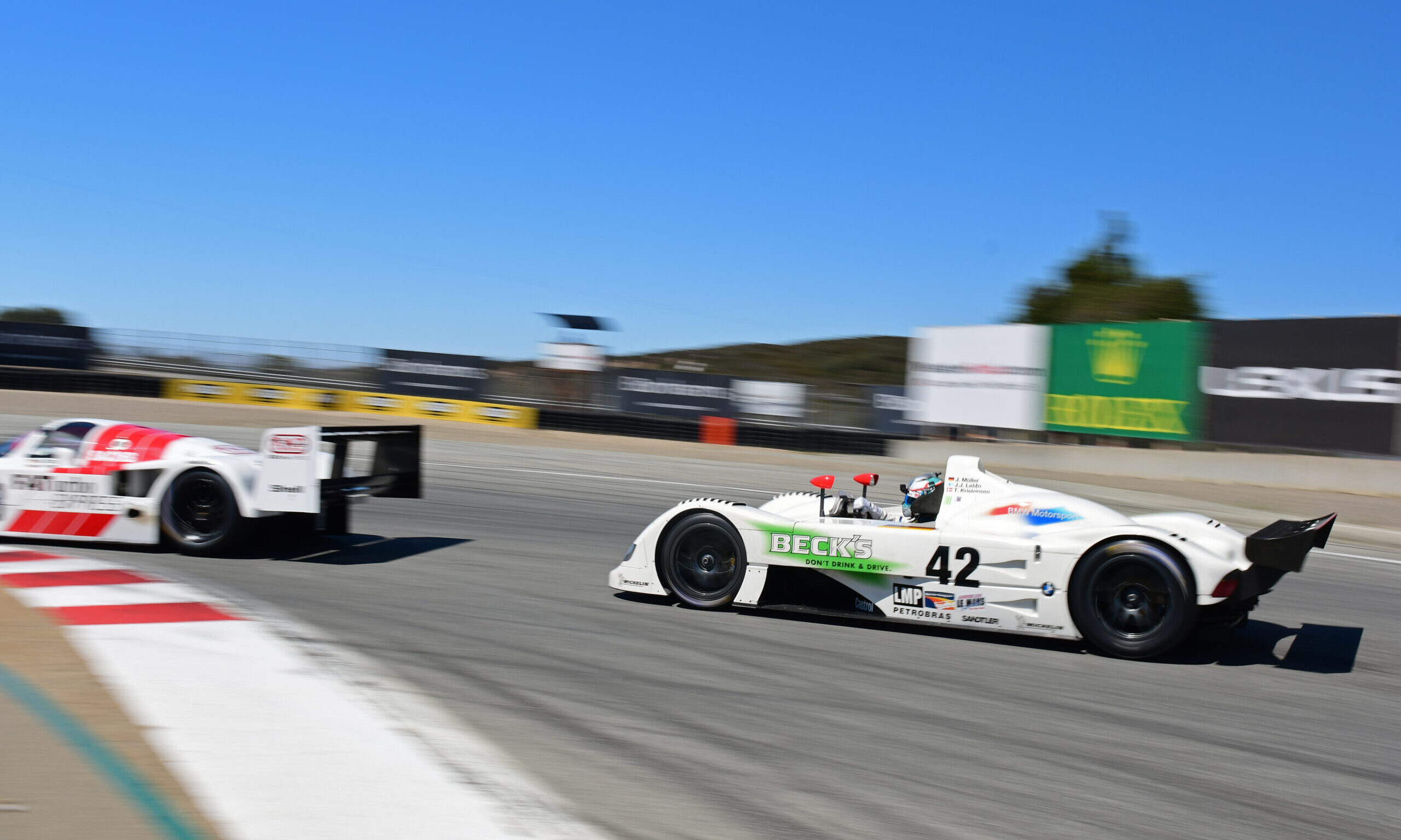
Connor DePhillippi is one of the few drivers to experience the last (1999) and the latest BMW prototype race cars, seen here at Laguna Seca in August.
DePhillippi handled those old-school nuances with aplomb recently, driving the LMR to group wins at the Rolex Monterey Motorsport Reunion in August. “As you transition to the BMW M Hybrid V8,” he adds, “you immediately feel the technology and sensitivity as soon as you enter the cockpit. There are buttons and switches giving you the feeling it can send you for a ride at any moment. On the track, it rewards precision and extra clean footwork due to the hybrid system. Driving as energy efficiently as possible will be a critical part of this new hybrid era, and it will offer new challenges to many of us drivers in the IMSA program.”
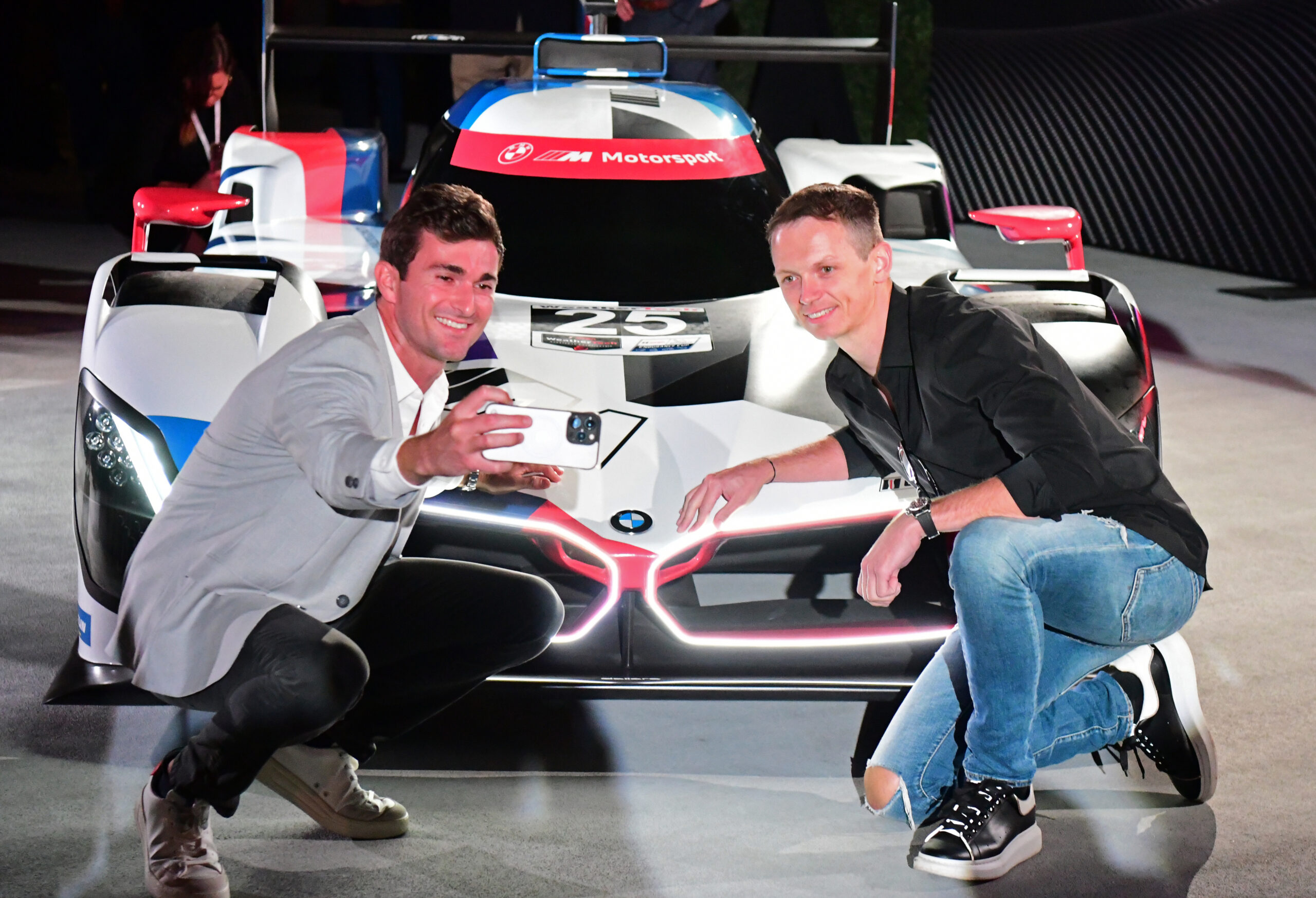
It wasn’t just invited guests and eager bloggers excited to see the BMW M Hybrid V8 in its racing livery. Connor DePhillippi and Nick Yelloly hit that selfie button in front of the car and its unique illuminated kidneys.
These cars won’t just be new to the drivers, they’ll be new to all of IMSA. “By bringing GTP back, IMSA is celebrating our past—but we’re also now on the launch pad to our future, and to the future of the auto industry,” IMSA president John Doonan told me. “Manufacturers want to talk about sustainability, and we have renewable fuel coming, the new hybrid powertrain unit, and reduced tire allocation from partner Michelin. Combine all those things and IMSA has the opportunity to be the most sustainable racing series in North America, if not the world.”

Leigh Diffey of NBC Sports talks with IMSA president John Doonan.
Daytona Prototype International (DPi) has been at the top of the grid, so to speak, but is now being supplanted by GTP as seasons move from 2022 into 2023. “GTP for IMSA was a highlight of our history in the early 1980s to early 1990s; it was a historic moment and golden era,” Doonan continued. “When we switched over to GTP, we really opened up the opportunity for design and styling to allow the brand to do more. Because of that, while it’s a prototype car, it emulates the GTs—the Grand Tourings—so you could pull up an M5 or M4 and recognize the brand, the family.”
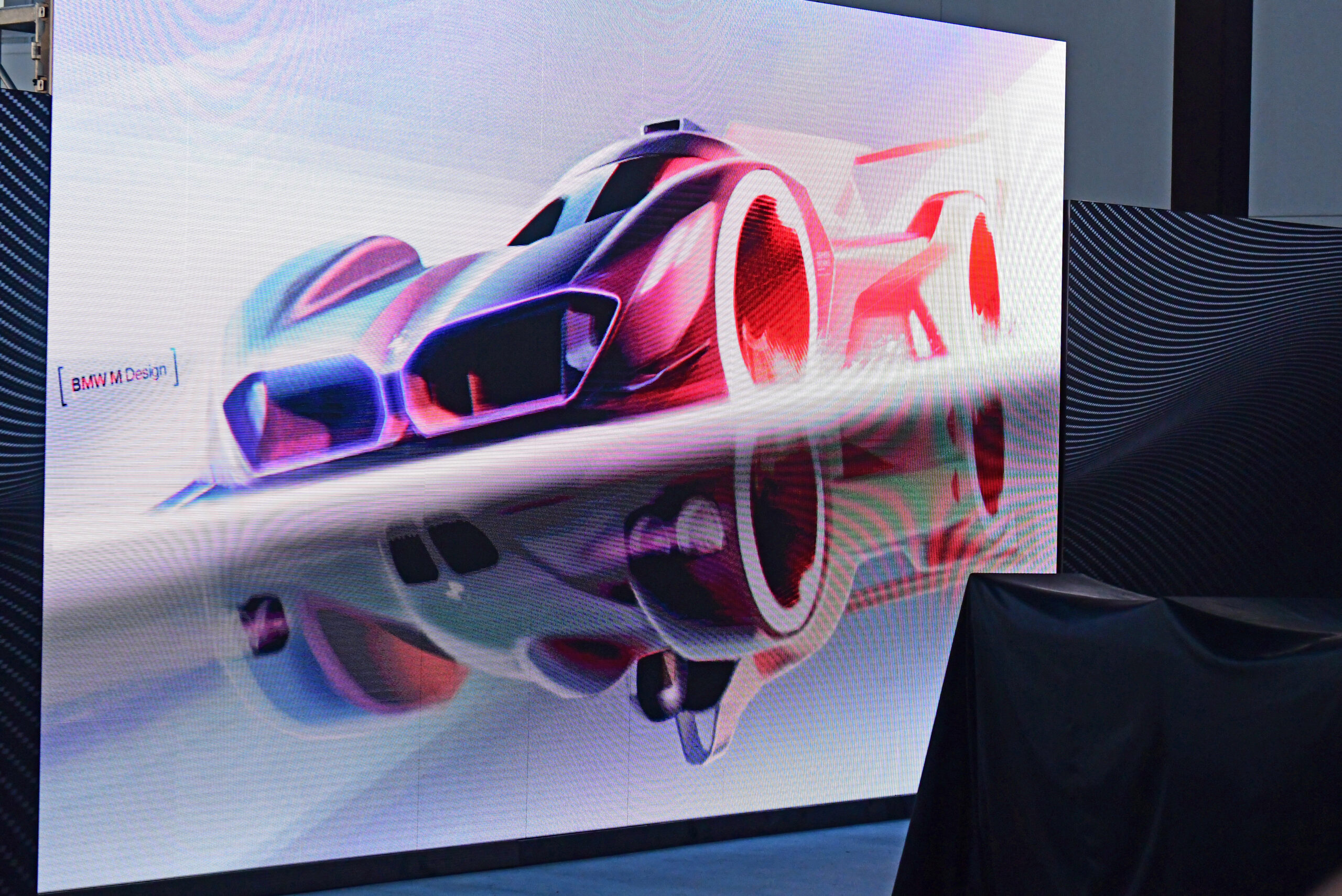
Closer inspection reveals the handing of the torch from the third-generation prototype car to the fourth.
“When I walked into the OEM design studios and explained to the designers like Michael Scully that they had the opportunity to design a race car, they were like kids in an art class,” Doonan continued. “Men and women who design road cars now have the opportunity to design the ultimate BMW [and other brands]. To give the OEMs this platform is an honor for us; that’s what we want IMSA to be. And BMW now is certainly in the running for best-looking one in the group. If you look right there, that is a BMW—a prototype race car, it is the ultimate expression of the BMW brand, from lighting, design, styling cues, the lines—it is the ultimate expression of the BMW brand.”
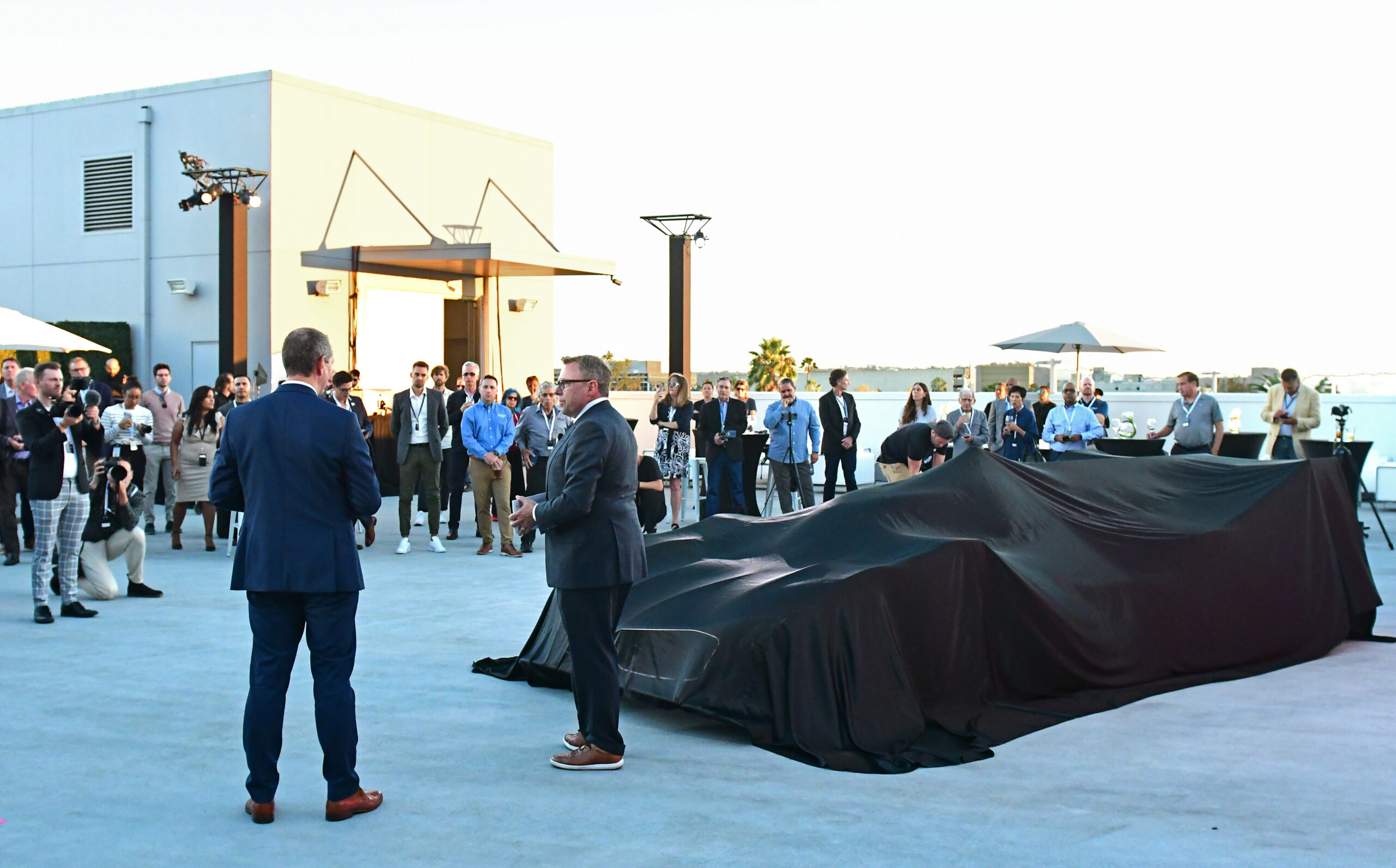
Even before the cover was lifted, BMW design cues were clear and apparent, seen here as Leigh Diffey talks with BMW M CEO Frank van Meel.
Doonan also stresses the connection between racing and road cars. “We’re seeing the ultimate sustainability, ultimate in design and expression, and ultimate performance. And by tying all those things together and also talking about unveiling a road car soon with the engine and powertrain aligning with this GTP car, that is the ultimate in race track as a laboratory to road-car efficiency.”

It’s tough not to get excited when we see and hear the enthusiasm designer Michael Scully brings to the project.
I didn’t doubt him at all, but I did want to check with Michael Scully, global director of automotive and advanced design for BMW Group Designworks, for his perspective. “I have to say that on a personal level, this one is very close to my heart,” Scully says. “I have raced prototypes myself, starting around 1995 racing open-cockpit two-liter prototype cars, and have been involved with prototypes most of my life. Now, to work on the fourth generation of BMW prototypes is super special. It’s a tough project to beat!”
That speaks volumes for Scully, too; he was involved in the design of the BMW bobsled that the US Olympics team rode to their first medals in 62 years. “The bobsled project was super-rewarding, too, but it was also similar to this project,” Scully says. “Regulations for bobsled design are really tight, so the regulations were very claustrophobic. But as a designer, I find it rewarding to make it work. If there were no restrictions, it would almost be like art; you can do what you want. But the distinction between art and design is that with design, you’re serving a functional component—and hopefully doing so cleverly. When you have those regulations, it’s actually pretty fun to find new solutions that go faster.”

The second- and third-generation prototype cars were certainly striking in their day (and even now!), but were much more wedge-like than the fourth-generation car.
We can see how this experience parallels the design of this Hybrid V8, and how that becomes critically important in the continued electrification of M. “The open architecture to the front of the car is really important,” Scully added. “That’s kind of the avant-garde approach to sports-car prototype aerodynamics. If you look at the 1999 LM or the ’86 car… those are very wedge-shaped. I am super-happy with the open architecture at the front of this GTP because it gives the chance for the kidneys to be totally essential to the aerodynamic performance of the car, and I love it when there’s that interrelationship between brand identify and absolute function—and that’s what this project is all about. I’m happy that people seem to respond to it.”

Fortunately for all in attendance, the Hybrid V8 only had David Letterman speechless for a brief moment. (BMW Team RLL namesakes Bobby Rahal and Patrick Lanigan are to the right with Leigh Diffey.)
When David Letterman, one of the L’s in BMW Team RLL, saw the car, he was in awe. “This is the kind of car that really reminds you and informs people of why there is still motorsports on the planet,” he said to the crowd. “There is only one thing this machine is made to do, and it could be doing it right now. I don’t know, it’s either parked or it’s going 200; it’s impossible to know the difference.” He added that his first car was a BMW.

Bobby Rahal, now of BMW M Team RLL, has history with these prototypes that extends back to driving the 1986 March 86G BMW GTP car, actually once landing upside down at Sebring.
I asked the R in RLL, Bobby Rahal, how he likes the car, and he had similar feelings. “This is very cool. This is the first time I’ve seen the car in real life,” he said. “If the car looks right, it usually is—and this car looks right. I’m already very excited about it, because we’ve been working on this program for the last several months, and now we have it out testing—and that’s exciting. We look forward to the new year. It’s a big challenge, but we’re going to meet that challenge.”
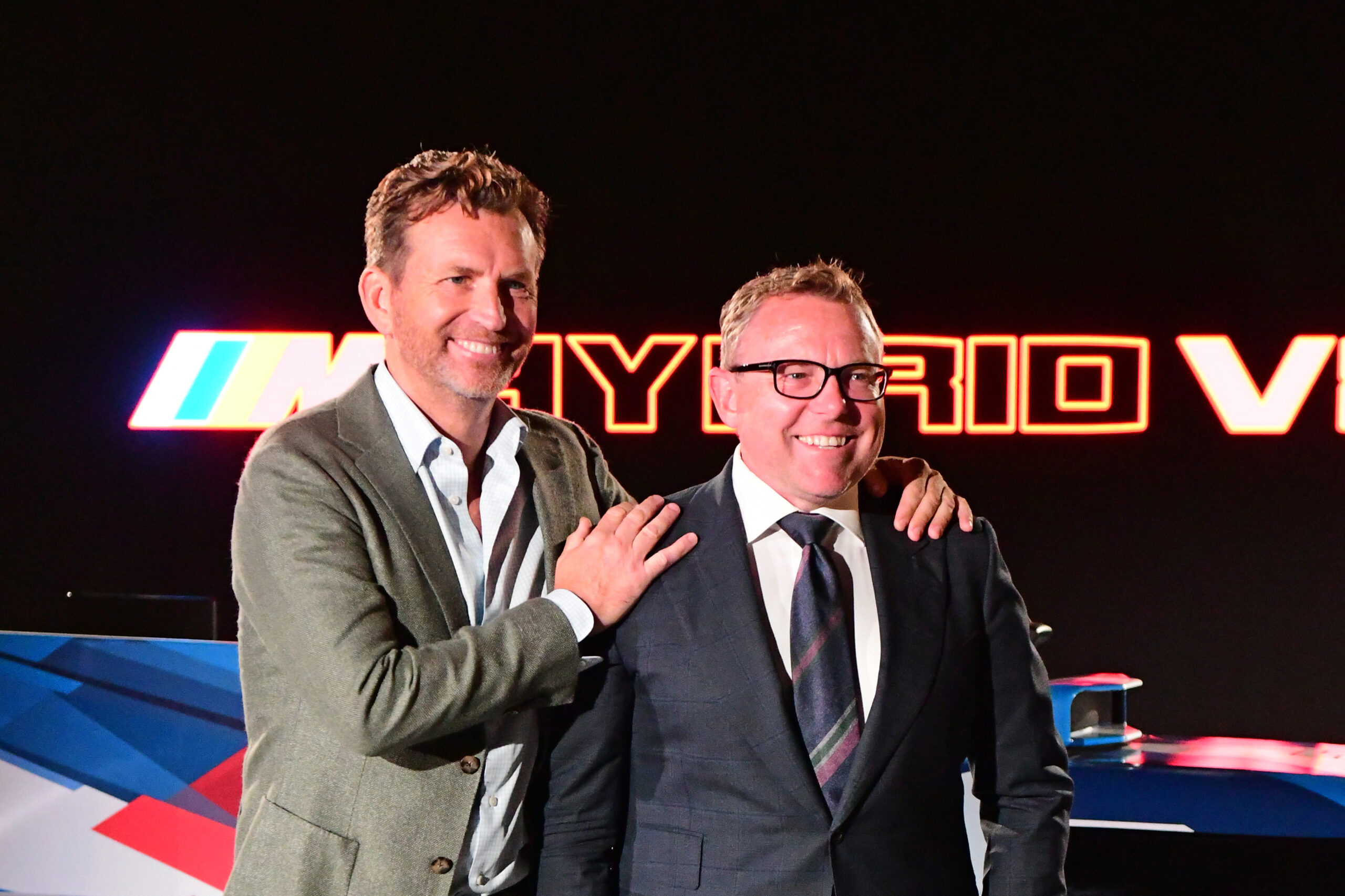
Motorsport media luminaries Justin Bell and emcee Leigh Diffey pause for a photo during the premiere.
Just so you know that it isn’t only BMW employees and loyalists who raved about the car, I asked racing legend and 24 Hour of Le Mans GT2 class-winner Justin Bell for his opinion. “As long as I can remember seeing BMW race cars out on track, they have seemed to me to be a vital part of our sports-car scene,” Bell said. “And we have history, too. Not only did my dad race the famous Batmobile back in the day, but it was a BMW engine that so magnificently powered our podium-placing McLaren F1 GTR! During my Viper years, when we pretty much dominated the GT racing championships, BMWs were also winning nearly everything in the prototype division. We were often on the podiums together, which is a pretty cool memory.”

BMW design themes are clear and functional on the Hybrid V8.
Bell adds, “So to see BMW back in the premiere category with this stunning-looking Hybrid V8, complete with BMW design cues, makes me very excited for what next season in IMSA will bring! They know how to develop these complete race drivers who have such loyalty and passion for the band that I think it goes a long way toward their winning ways, too. This new category in world sports-car racing has attracted the top OEMs, with the best teams and the brightest minds to develop their LMDh contenders. The competition will be fierce!”
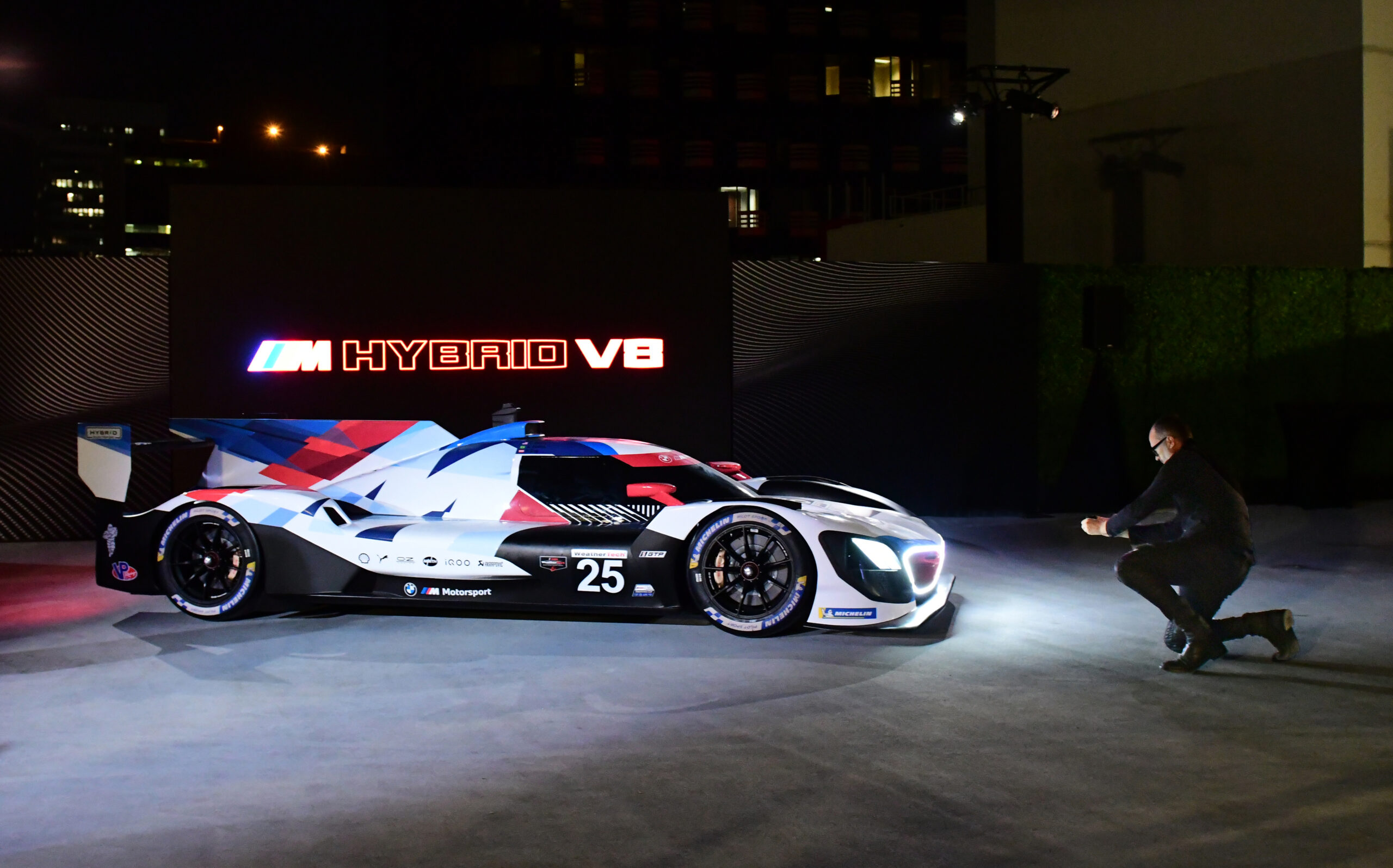
As the night wound to a close, Michael Scully took another picture of his team’s latest creation.
That was a common sentiment among seemingly all in attendance. Doonan added, “If you like IMSA racing now, wait: It’s going to get even better. To have all those brands racing for the overall victory in combination of having one of the largest GT fields representing ten-plus brands, we’ll have the best manufacturers in the world running. We’re in store for a very exciting 2023, and then we really hit our stride in 2024 when we add another brand—and potentially a couple more who are researching it, too. This is an incredible time for motorsports overall, but for endurance sports-car racing specifically. Now we’re reaching for the pinnacle.”—Kyle van Hoften






